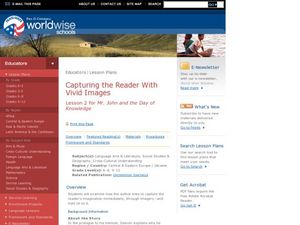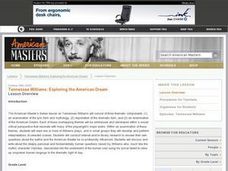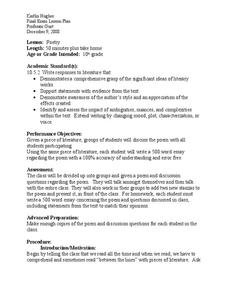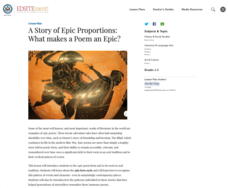Shmoop
ELA.CCSS.ELA-Literacy.RL.11-12.6
It ‘s assessment check list time, and you have nothing to prove that your learners mastered the skill RL.11-12.6. Rest assured, here is a plan that is sure to appease your administrator. It offers solid examples on the difference between...
Curated OER
Capturing the Reader with Vivid Images
In this using vivid images worksheet, pupils identify vivid images and analyze their effectiveness in John Deever's "Mr. John and the Day of Knowledge." Students then write rich images for their classmates to imagine.
Curated OER
Introducing Literary Elements in Fiction
Identify literary elements in fiction. In this reading comprehension lesson plan, learners read the book Pigsty and record literary elements onto a graphic organizer. They specifically discuss the main characters and events in the text.
Curated OER
Fairy Tales
Class groups examine fairy tales from a feminist and a Marxist perspective, identifying how these tales present gender roles and class/power systems. The groups then script and perform their own tale that uses one of these lenses.
Curated OER
Literary Elements Worksheets and Graphic Organizers
Using graphic organizers can be an effective way to teach literary elements.
Curated OER
Tennessee Williams: Exploring the American Dream
Young scholars read and analyze selections of Tennessee Williams' work. They write journal responses, conduct Internet research, perform various scenes from one of Williams' dramas, and create a presentation.
Curated OER
Poetry
Tenth graders write a poem. In this poetry lesson, 10th graders read the poem The Road Not Taken written by Robert Frost, answer discussion questions, add new stanzas to the poem and share them with the class.
Curated OER
Dictators
Students can learn about the elements of a dictatorship through these lessons.
Curated OER
Let's Trade! The Prince and the Pauper
Students read and analyze the novel, The Prince and the Pauper. They examine character development, discuss opinions using text, and develop and present a slide show demonstrating the development of a character from the beginning to the...
Curated OER
Teaching Students to Support Their Opinions with Appropriate Details
Teaching students to support their opinions in the language arts classroom.
National Endowment for the Humanities
Folklore in Zora Neale Hurston's Their Eyes Were Watching God
Learners define folklore, folk groups, tradition, and oral narrative. They identify traditional elements in Their Eyes Were Watching God Analyze and understand the role of traditional folkways and folk speech in the overall literary...
Curated OER
Exploring Heroism
Students examine the concept of heroism in this lesson, through personal reflection, group activities and a thoughtful analysis of the documentary, HEROES OF GROUND ZERO. They explore their own understanding of what it means to be a hero.
Curated OER
Headless Horseman, Heady Author
Twelfth graders explore figurative language as it appears in Washington Irving's original text, The Legend of Sleepy Hollow, answer questions based on story, and write sequels to it by using the different types of figurative language...
Curated OER
Capturing the Reader With Vivid Images
Students examine how the author tries to capture the reader's imagination immediately, through imagery--and hold on to it. They locate Ukraine on a world map and understand Lenin's role in the establishment of Russian communism and the...
Peace Corps
Starting Off the Day (and School Year) in Ukraine
Students compare the first day of school in Ukraine with the first day of school in the United States, including the challenges students and teachers both face in each country. They respond in class, in their journals, to the following...
Curated OER
A Picture's Worth 500-700 Words: Neoclassical Painting Analysis and Creative Write
Middle schoolers survey Neoclassical art and create a narrative based on their analyses. Focused questions and relevant background information provided by the Getty Museum provides a great foundation for students to understand art...
Curated OER
Unit Plan for Mark Twain and American Humor
Students create brochures about the humor of Mark Twain. In this literature-analysis lesson plan, students read "The Celebrated Jumping Frog of Calaveras County" and other short stories by Twain. Students write analytical paragraphs and...
National Endowment for the Humanities
A Story of Epic Proportions: What Makes a Poem an Epic?
Learners analyze the epic poem form and its roots in oral tradition. For this epic poetry lesson, young scholars research the epic hero cycle and recognize the pattern of events and elements. Learners analyze the patterns embedded in the...
Curated OER
Heaven or Ground Hog Day?
Learners discover the ideas of enlightenment by reading historical poetry. In this philosophical lesson, students read poems by Sir Walter Scott and Sergeant Joyce Kilmer while discussing the themes of the writing with classmates....
Curated OER
Writing Folktales
Students consider the structure of folktales. In this writing skills instructional activity, students list the attributes of folktales that they read in class. Students then complete handouts based on the elements of the tales as well as...
Curated OER
Mystic Lands: Maya: Messages in Stone
Students explore an ancient Mayan city. In this world history lesson, students watch a video about the ancient Mayan civilization, discussing information prior to and after watching the video. Students then come to understand more about...
Curated OER
The French Revolution
French Revolution lessons can help students explore the political, social, and economic issues of the time.
Curated OER
"Et tu, Brute?" - The Characters, Conflict and Historical context of Shakespeare's Julius Caesar
Students analyze the Shakespearian play, "Julius Caesar" in this seven lesson unit. Through readings, hands-on projects, and the study of plot development, comparisons are made to the movie and the historical records available.
Curated OER
Analysis of Character in a Short Story
Ninth graders examine a character from the short story, John Steinbeck's, "Flight." students respond to questions about the story and illustrate the character's journey.

























